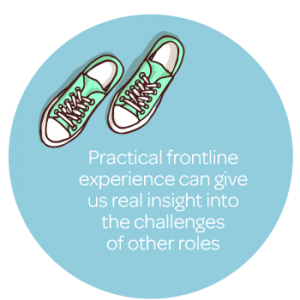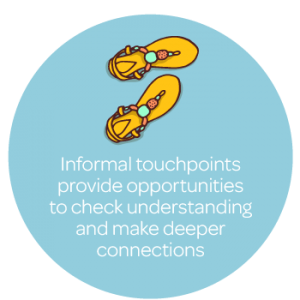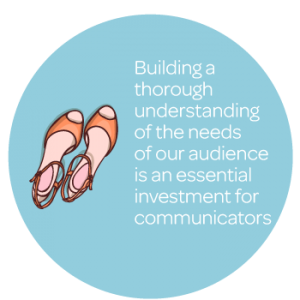In To Kill a Mockingbird, Atticus Finch famously taught his daughter Scout that you never really understand someone until you’ve stood in their shoes and walked around in them.
That advice holds good for internal communicators too.
According to Liam Fitzpatrick and Klavs Valskov, authors of Internal Communications: A Manual for Practitioners, communicators can only function when we understand our audiences. “Being able to reflect on how staff feel, what they might understand and how they might react to a message,” they write, “adds value to our advice and differentiates it from the guesswork and speculation of other senior people.”
Internal communicators have a range of channels in their arsenal to seek their employees’ views. Surveys, forums, focus groups, social networks, ideas schemes: they can all be used to good effect.
And while feedback tools are essential for any organisation, there are tactics we can use as individuals to take our personal insight to another level.
These approaches can help you ‘step into the shoes’ of your audience – and keep them front of mind too. They’ll set you apart as a trusted adviser, giving you deeper insight into your audience and a rich source of stories that can be highly persuasive when influencing senior leaders.
After all, what leader wouldn’t want advice from someone who shows they have their ear close to the ground?
Get frontline experience
When former Asda CEO and Royal Mail Chairman Allan Leighton started as a graduate trainee at Mars, he was assigned to the Maltesers production line. His role? To pick up errant chocolates that tumbled off the conveyer belt.
Only after a frustrating morning spent pursuing them across the floor did his amused co-workers share the trade secret: step on them first, then sweep them up. With this secret, as Allan later wrote in On Leadership, they shared an important lesson: “operators know best, and getting close to them is key.”
Getting practical frontline experience is not just the preserve of graduate inductions or CEOs on reality TV shows. As communicators it can give us real insight into the challenges of other roles. It also helps build relationships and trust, and encourages frontline colleagues to share their true views more readily.
Managing by Walking Around
The origin of Managing by Walking Around (MBWA) can apparently be traced back to Abraham Lincoln’s practice of visiting troops on battlefields in the American Civil War. A century later management consultant Tom Peters helped promote its use as a tool to help leaders uncover the real issues in their organisations.
For internal communicators it can be useful not just for building relationships and networks, but also for checking how key messages have landed and been understood.
So how do you do it? Simply schedule a regular time to walk around your workplace and chat informally to colleagues. Arm yourself with open questions first. Check perceptions of recent messages. Or try a question like: “If there’s one thing we could do to improve communication round here, what would it be?”
Informal touchpoints
MBWA relies on regular, scheduled time to ensure it takes place. But each day is also filled with informal opportunities to get to know your audience better – at the coffee machine, in the lift, while walking around the office.
As communicators, it pays to make the most of these opportunities. In fact, Liam Fitzpatrick and Klavs Valskov argue that if you lunch alone or at your desk, you’re not doing your job properly. You may not want to sacrifice every lunch break, but making the most of each interaction pays dividends.
Doug Conant, former CEO of Campbell’s Soup, called these informal moments ‘touchpoints’. For leaders, Conant writes, each moment is an opportunity to “infuse the agenda with greater clarity and more energy, and to influence the course of events.”
For communicators, each touchpoint is an opportunity to make a deeper connection, to check understanding, to gain insight into how your audience feels.
Build your networks
In the 1930s, Franklin D Roosevelt became the first American President to cultivate a network of sources outside the federal government. Roosevelt drew on the views of businessmen, academics, friends and relatives to find out what was happening ‘on the ground’, rather than relying solely on official sources.
We can take a leaf out of Roosevelt’s book by establishing our own networks to keep our finger on our organisation’s pulse.
Retail giants like M&S and Sainsbury’s have highly-developed employee representative groups which are great sources to tap into. If groups like this don’t already exist in your organisation, why not set up your own?
Start an engagement group. If you’re tackling change, organise a network of change champions. Or simply set up an informal group of contacts across your organisation with whom you hold regular calls or meetings. The possibilities are endless.
Get your employees in the room
Even when you understand the needs of your audience, it can be easy to overlook them on a day-to-day basis. And while it’s usually a good idea to involve your audience in developing your proposals, it isn’t always practical.
This is where visual cues can help.
At the Big Yak in 2014, one attendee described an organisation that always has an empty chair at meetings. Its purpose? To symbolically represent the rest of the company, and give them a silent voice. 
Your choice of workspace can also help. In Pre-Suasion, influence expert Robert Cialdini notes that visual cues in meeting rooms helped consultants generate better solutions. Using glass-fronted meeting rooms in busy areas did the trick. So did printing large ‘action pictures’ of employees working, and displaying them on their meeting room walls.
In summary
Building a thorough understanding of the needs of our audience takes time, but it’s an essential investment for communicators.
By stepping into our audience’s shoes on a regular basis we can give ourselves a unique insight into their needs – and actively use that insight to improve our organisations.
By Dave Wraith for Alive!
















